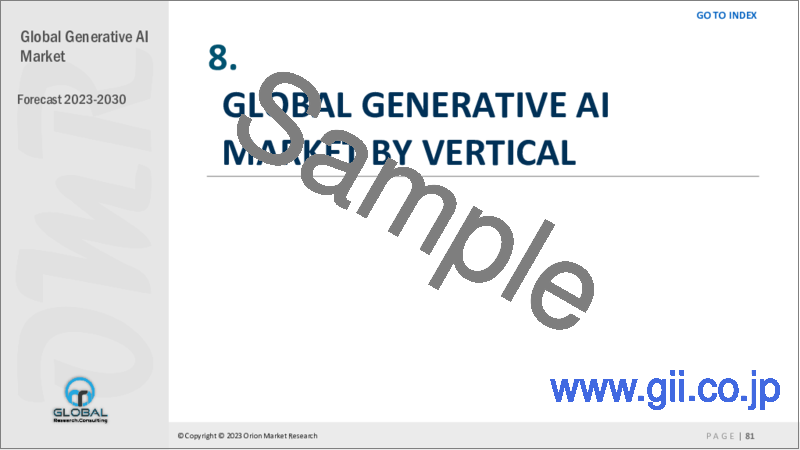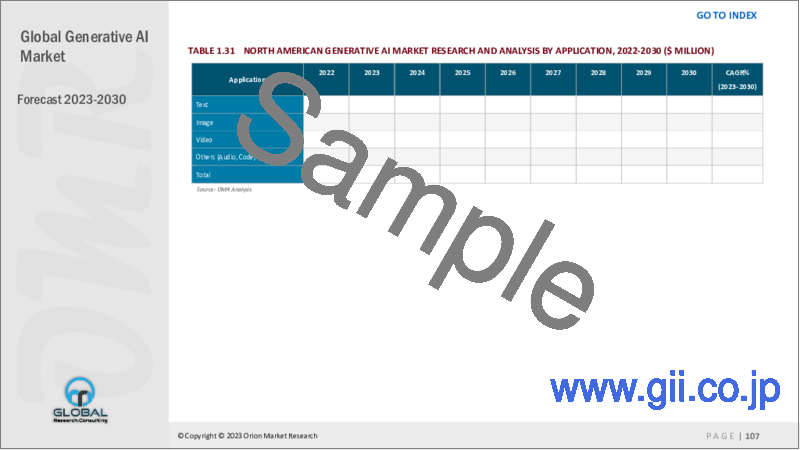|
|
市場調査レポート
商品コード
1364001
生成AIの世界市場:2023-2030年Global Generative AI Market 2023-2030 |
||||||
カスタマイズ可能
|
|||||||
| 生成AIの世界市場:2023-2030年 |
|
出版日: 2023年09月24日
発行: Orion Market Research
ページ情報: 英文 180 Pages
納期: 2~3営業日
|
- 全表示
- 概要
- 図表
- 目次
世界の生成AI市場は、予測期間中に48.5%というかなりのCAGRで成長すると予測されています。生成AI(人工知能)は、プロンプトに応じてテキスト、画像、動画などの新しいコンテンツを生成できるAIの一種です。生成AIモデルは、入力訓練データのパターンと構造を学習し、類似した特性を持つ新しいデータを生成します。生成AIモデルは、テキスト、コード、画像などの大規模なデータセットで学習されます。より多くのデータが利用可能になるにつれて、生成AIモデルはよりリアルでクリエイティブなコンテンツを生成できるようになります。生成AIモデルは、テキスト、コード、または画像の大規模なデータセットで学習されます。これは、モデルが生成するはずのコンテンツの種類の多種多様な例にさらされることを意味します。
コードのデータセットで訓練された生成AIモデルは、ソフトウェア・アプリケーションやWebサイトなどの新しいコードを生成するために使用できます。このモデルは、データセットのコードに似たコードを生成することができますが、新しいオリジナルのコードを生成することもできます。DALL-E 2は、テキストと画像のデータセットで学習される生成AIモデルです。DALL-E 2は、テキスト記述から画像を生成するために使用することができます。
セグメント別の見通し
ソフトウェアが生成AI市場で大きなシェアを占める
医療、金融、製造業など、生成AIソフトウェアの幅広い用途で高い需要があることから、2022年の生成AI市場ではソフトウェア分野が大きなシェアを占めました。クラウドベースの生成AIソフトウェアソリューションの採用が増加しているため、企業は生成AIの導入と利用が容易になっています。オープンソースの生成AIソフトウェア・ライブラリの利用可能性が高まっているため、開発者は生成AIアプリケーションを容易に構築できます。
地域別展望
アジア太平洋地域が世界市場で大きなシェアを占める
アジア太平洋地域には、アリババ、バイドゥ、テンセントなどの大手テクノロジー企業があります。これらの企業は生成AIの研究開発に多額の投資を行っており、ビジネス向けの生成AIアプリケーションも開発しています。例えば、バイドゥの共同創業者でCEOのロビン・リーは2023年6月、生成AI企業を支援する10億元(1億4,500万米ドル)ファンドの立ち上げを発表しました。この投資は、この地域における生成AI市場の成長を後押ししています。
目次
第1章 レポート概要
- 業界の現状分析と成長可能性の展望
- 調査方法とツール
- 市場内訳
- セグメント別
- 地域別
第2章 市場概要と洞察
- 調査範囲
- アナリストの洞察と現在の市場動向
- 主な調査結果
- 推奨事項
- 結論
第3章 競合情勢
- 主要企業分析
- Microsoft, Corp.
- 概要
- 財務分析
- SWOT分析
- 最近の動向
- Google LLC
- 概要
- 財務分析
- SWOT分析
- 最近の動向
- IBM Corp.
- 概要
- 財務分析
- SWOT分析
- 最近の動向
第4章 市場セグメンテーション
- 世界の生成AI市場:提供別
- ソフトウェア
- サービス
- 世界の生成AI市場:用途別
- テキスト
- 画像
- 動画
- その他(音声、コード)
- 世界の生成AI市場:ビジネス機能別
- マーケティング・営業
- 人事
- 財務
- 研究開発
- その他(カスタマーサービス、教育)
- 世界の生成AI市場:業種別
- BFSI
- IT・通信
- 医療
- 小売業・eコマース
- 製造業
- メディア・ユーティリティ
- 建設・不動産
- その他(政府・防衛、エネルギー・ユーティリティ、その他)
第5章 地域分析
- 北米
- 米国
- カナダ
- 欧州
- 英国
- ドイツ
- イタリア
- スペイン
- フランス
- その他欧州
- アジア太平洋
- 中国
- インド
- 日本
- 韓国
- その他アジア太平洋
- 世界のその他の地域
- ラテンアメリカ
- 中東・アフリカ
第6章 企業プロファイル
- Adobe, Inc.
- AI21 Labs
- Amazon Web Services, Inc.
- Anthropic PBC
- Bazaarvoice, Inc.
- Cisco Systems, Inc.(MindMeld)
- Cognizant, Inc.
- Cohere, Inc.
- Dataiku
- Fractal Analytics Pvt., Ltd.
- Genie AI Ltd.
- Hugging Face, Inc.
- MOSTLY AI Solutions MP GmbH
- NVIDIA Corporation
- OpenAI
- Regie.ai
- Rephrase Technologies Pvt. Ltd
- Salesforce, Inc.
- SAP SE
- Stability AI
- Synthesis AI
LIST OF TABLES
- 1. GLOBAL GENERATIVE AI MARKET RESEARCH AND ANALYSIS BY OFFERING, 2023-2030 ($ MILLION)
- 2. GLOBAL GENERATIVE AI SOFTWARE MARKET RESEARCH AND ANALYSIS BY REGION, 2023-2030 ($ MILLION)
- 3. GLOBAL GENERATIVE AI SERVICES MARKET RESEARCH AND ANALYSIS BY REGION, 2023-2030 ($ MILLION)
- 4. GLOBAL GENERATIVE AI MARKET RESEARCH AND ANALYSIS BY APPLICATION, 2023-2030 ($ MILLION)
- 5. GLOBAL GENERATIVE AI FOR TEXT MARKET RESEARCH AND ANALYSIS BY REGION, 2023-2030 ($ MILLION)
- 6. GLOBAL GENERATIVE AI FOR IMAGE MARKET RESEARCH AND ANALYSIS BY REGION, 2023-2030 ($ MILLION)
- 7. GLOBAL GENERATIVE AI FOR VIDEO MARKET RESEARCH AND ANALYSIS BY REGION, 2023-2030 ($ MILLION)
- 8. GLOBAL GENERATIVE AI FOR OTHERS MARKET RESEARCH AND ANALYSIS BY REGION, 2023-2030 ($ MILLION)
- 9. GLOBAL GENERATIVE AI MARKET RESEARCH AND ANALYSIS BY BUSINESS FUNCTION, 2023-2030 ($ MILLION)
- 10. GLOBAL GENERATIVE AI FOR MARKETING AND SALES MARKET RESEARCH AND ANALYSIS BY REGION, 2023-2030 ($ MILLION)
- 11. GLOBAL GENERATIVE AI FOR HUMAN RESOURCE MARKET RESEARCH AND ANALYSIS BY REGION, 2023-2030 ($ MILLION)
- 12. GLOBAL GENERATIVE AI FOR FINANCE MARKET RESEARCH AND ANALYSIS BY REGION, 2023-2030 ($ MILLION)
- 13. GLOBAL GENERATIVE AI FOR RESEARCH AND DEVELOPMENT MARKET RESEARCH AND ANALYSIS BY REGION, 2023-2030 ($ MILLION)
- 14. GLOBAL GENERATIVE AI FOR OTHERS MARKET RESEARCH AND ANALYSIS BY REGION, 2023-2030 ($ MILLION)
- 15. GLOBAL GENERATIVE AI MARKET RESEARCH AND ANALYSIS BY VERTICAL, 2023-2030 ($ MILLION)
- 16. GLOBAL GENERATIVE AI FOR BFSI MARKET RESEARCH AND ANALYSIS BY REGION, 2023-2030 ($ MILLION)
- 17. GLOBAL GENERATIVE AI FOR IT AND TELECOMMUNICATION MARKET RESEARCH AND ANALYSIS BY REGION, 2023-2030 ($ MILLION) MARKET RESEARCH AND ANALYSIS BY REGION, 2023-2030 ($ MILLION)
- 18. GLOBAL GENERATIVE AI FOR MEDIA AND ENTERTAINMENT MARKET RESEARCH AND ANALYSIS BY REGION, 2023-2030 ($ MILLION)
- 19. GLOBAL GENERATIVE AI FOR CONSTRUCTION AND REAL ESTATE MARKET RESEARCH AND ANALYSIS BY REGION, 2023-2030 ($ MILLION)
- 20. GLOBAL GENERATIVE AI FOR HEALTHCARE MARKET RESEARCH AND ANALYSIS BY REGION, 2023-2030 ($ MILLION)
- 21. GLOBAL GENERATIVE AI FOR RETAIL AND E-COMMERCE MARKET RESEARCH AND ANALYSIS BY REGION, 2023-2030 ($ MILLION)
- 22. GLOBAL GENERATIVE AI FOR MANUFACTURING MARKET RESEARCH AND ANALYSIS BY REGION, 2023-2030 ($ MILLION)
- 23. GLOBAL GENERATIVE AI FOR OTHERS (MEDIA AND ENTERTAINMENT) MARKET RESEARCH AND ANALYSIS BY REGION, 2023-2030 ($ MILLION)
- 24. GLOBAL GENERATIVE AI MARKET RESEARCH AND ANALYSIS BY REGION, 2023-2030 ($ MILLION)
- 25. NORTH AMERICAN GENERATIVE AI MARKET RESEARCH AND ANALYSIS BY COUNTRY, 2023-2030 ($ MILLION)
- 26. NORTH AMERICAN GENERATIVE AI MARKET RESEARCH AND ANALYSIS BY OFFERING, 2023-2030 ($ MILLION)
- 27. NORTH AMERICAN GENERATIVE AI MARKET RESEARCH AND ANALYSIS BY APPLICATION, 2023-2030 ($ MILLION)
- 28. NORTH AMERICAN GENERATIVE AI MARKET RESEARCH AND ANALYSIS BY BUSINESS FUNCTION, 2023-2030 ($ MILLION)
- 29. NORTH AMERICAN GENERATIVE AI MARKET RESEARCH AND ANALYSIS BY VERTICAL, 2023-2030 ($ MILLION)
- 30. EUROPEAN GENERATIVE AI MARKET RESEARCH AND ANALYSIS BY COUNTRY, 2023-2030 ($ MILLION)
- 31. EUROPEAN GENERATIVE AI MARKET RESEARCH AND ANALYSIS BY OFFERING, 2023-2030 ($ MILLION)
- 32. EUROPEAN GENERATIVE AI MARKET RESEARCH AND ANALYSIS BY APPLICATION, 2023-2030 ($ MILLION)
- 33. EUROPEAN GENERATIVE AI MARKET RESEARCH AND ANALYSIS BY BUSINESS FUNCTION, 2023-2030 ($ MILLION)
- 34. EUROPEAN GENERATIVE AI MARKET RESEARCH AND ANALYSIS BY VERTICAL, 2023-2030 ($ MILLION)
- 35. ASIA-PACIFIC GENERATIVE AI MARKET RESEARCH AND ANALYSIS BY COUNTRY, 2023-2030 ($ MILLION)
- 36. ASIA-PACIFIC GENERATIVE AI MARKET RESEARCH AND ANALYSIS BY OFFERING, 2023-2030 ($ MILLION)
- 37. ASIA-PACIFIC GENERATIVE AI MARKET RESEARCH AND ANALYSIS BY APPLICATION, 2023-2030 ($ MILLION)
- 38. ASIA-PACIFIC GENERATIVE AI MARKET RESEARCH AND ANALYSIS BY BUSINESS FUNCTION, 2023-2030 ($ MILLION)
- 39. ASIA-PACIFIC GENERATIVE AI MARKET RESEARCH AND ANALYSIS BY BUSINESS VERTICAL, 2023-2030 ($ MILLION)
- 40. REST OF THE WORLD GENERATIVE AI MARKET RESEARCH AND ANALYSIS BY COUNTRY, 2023-2030 ($ MILLION)
- 41. REST OF THE WORLD GENERATIVE AI MARKET RESEARCH AND ANALYSIS BY OFFERING, 2023-2030 ($ MILLION)
- 42. REST OF THE WORLD GENERATIVE AI MARKET RESEARCH AND ANALYSIS BY APPLICATION, 2023-2030 ($ MILLION)
- 43. REST OF THE WORLD GENERATIVE AI MARKET RESEARCH AND ANALYSIS BY BUSINESS FUNCTION, 2023-2030 ($ MILLION)
- 44. REST OF THE WORLD GENERATIVE AI MARKET RESEARCH AND ANALYSIS BY VERTICAL, 2023-2030 ($ MILLION)
LIST OF FIGURES
- 1. GLOBAL GENERATIVE AI MARKET SHARE BY OFFERING, 2023 VS 2030 (%)
- 2. GLOBAL GENERATIVE AI FOR SOFTWARE MARKET SHARE BY REGION, 2023 VS 2030 (%)
- 3. GLOBAL GENERATIVE AI FOR SERVICES MARKET SHARE BY REGION, 2023 VS 2030 (%)
- 4. GLOBAL GENERATIVE AI MARKET SHARE BY APPLICATION, 2023 VS 2030 ($ MILLION)
- 5. GLOBAL GENERATIVE AI FOR TEXT MARKET SHARE BY REGION, 2022 VS. 2030 (%)
- 6. GLOBAL GENERATIVE AI FOR IMAGE MARKET SHARE BY REGION, 2023 VS 2030 (%)
- 7. GLOBAL GENERATIVE AI FOR VIDEO MARKET SHARE BY REGION, 2023 VS 2030 (%)
- 8. GLOBAL GENERATIVE AI FOR OTHERS (PRODUCT DESIGN) MARKET SHARE BY REGION, 2023 VS 2030 (%)
- 9. GLOBAL GENERATIVE AI MARKET SHARE BY BUSINESS FUNCTION, 2023 VS 2030 ($ MILLION)
- 10. GLOBAL GENERATIVE AI FOR MARKETING AND SALES MARKET SHARE BY REGION, 2023 VS 2030 (%)
- 11. GLOBAL GENERATIVE AI FOR FINANCE MARKET SHARE BY REGION, 2023 VS 2030 (%)
- 12. GLOBAL GENERATIVE AI FOR HUMAN RESOURCE MARKET SHARE BY REGION, 2023 VS 2030 (%)
- 13. GLOBAL GENERATIVE AI FOR RESEARCH AND DEVELOPMENT MARKET SHARE BY REGION, 2023 VS 2030 (%)
- 14. GLOBAL GENERATIVE AI FOR OTHERS MARKET SHARE BY REGION, 2023 VS 2030 (%)
- 15. GLOBAL GENERATIVE AI MARKET SHARE BY VERTICAL, 2023 VS 2030 ($ MILLION)
- 16. GLOBAL GENERATIVE AI FOR BFSI MARKET SHARE BY REGION, 2023 VS 2030 (%)
- 17. GLOBAL GENERATIVE AI FOR IT AND TELECOMMUNICATION MARKET SHARE BY REGION, 2023 VS 2030 (%)
- 18. GLOBAL GENERATIVE AI FOR MEDIA AND ENTERTAINMENT MARKET SHARE BY REGION, 2023 VS 2030 (%)
- 19. GLOBAL GENERATIVE AI FOR CONSTRUCTION AND REAL ESTATE MARKET SHARE BY REGION, 2023 VS 2030 (%)
- 20. GLOBAL GENERATIVE AI FOR HEALTHCARE MARKET SHARE BY REGION, 2023 VS 2030 (%)
- 21. GLOBAL GENERATIVE AI FOR RETAIL MARKET SHARE BY REGION, 2023 VS 2030 (%)
- 22. GLOBAL GENERATIVE AI FOR MANUFACTURING MARKET SHARE BY REGION, 2023 VS 2030 (%)
- 23. GLOBAL GENERATIVE AI FOR OTHERS (MEDIA AND ENTERTAINMENT) MARKET SHARE BY REGION, 2023 VS 2030 (%)
- 24. GLOBAL GENERATIVE AI MARKET SHARE BY REGION, 2023 VS 2030 (%)
- 25. US GENERATIVE AI MARKET SIZE, 2023-2030 ($ MILLION)
- 26. CANADA GENERATIVE AI MARKET SIZE, 2023-2030 ($ MILLION)
- 27. UK GENERATIVE AI MARKET SIZE, 2023-2030 ($ MILLION)
- 28. FRANCE GENERATIVE AI MARKET SIZE, 2023-2030 ($ MILLION)
- 29. GERMANY GENERATIVE AI MARKET SIZE, 2023-2030 ($ MILLION)
- 30. ITALY GENERATIVE AI MARKET SIZE, 2023-2030 ($ MILLION)
- 31. SPAIN GENERATIVE AI MARKET SIZE, 2023-2030 ($ MILLION)
- 32. REST OF EUROPE GENERATIVE AI MARKET SIZE, 2023-2030 ($ MILLION)
- 33. INDIA GENERATIVE AI MARKET SIZE, 2023-2030 ($ MILLION)
- 34. CHINA GENERATIVE AI MARKET SIZE, 2023-2030 ($ MILLION)
- 35. JAPAN GENERATIVE AI MARKET SIZE, 2023-2030 ($ MILLION)
- 36. SOUTH KOREA GENERATIVE AI MARKET SIZE, 2023-2030 ($ MILLION)
- 37. REST OF ASIA-PACIFIC GENERATIVE AI MARKET SIZE, 2023-2030 ($ MILLION)
- 38. LATIN AMERICA GENERATIVE AI MARKET SIZE, 2023-2030 ($ MILLION)
- 39. MIDDLE EAST AND AFRICA GENERATIVE AI MARKET SIZE, 2023-2030 ($ MILLION)
Title: Global Generative AI Market Size, Share & Trends Analysis Report Market by Offering (Software and Services), by Application (Text, Image, Video, and Others (Audio)), Business Function (Marketing and Sales, Finance, Human Resource, Research and Development, and Others (Customer service and Education)), Vertical (BFSI, IT and Telecommunication, Healthcare, Media and Entertainment, Retail and E-Commerce, Manufacturing, Construction and Real Estate, and Others)) Forecast Period (2022-2030).
Global generative AI market is anticipated to grow at a considerable CAGR of 48.5% during the forecast period. Generative artificial intelligence (AI) is a type of AI that can generate new content, such as text, images, or videos, in response to prompts. Generative AI models learn the patterns and structure of their input training data and then generate new data that has similar characteristics. Generative AI models are trained on large datasets of text, code, or images. As more and more data becomes available, generative AI models can produce more realistic and creative content. Generative AI models are trained on large datasets of text, code, or images. This means that the models are exposed to a wide variety of examples of the type of content that they are supposed to generate.
A generative AI model that is trained on a dataset of code can be used to generate new code, such as software applications and websites. The model will be able to generate code that is similar to the code in the dataset, but it will also be able to generate new and original code. DALL-E 2 is a generative AI model that is trained on a dataset of text and images. DALL-E 2 can be used to generate images from text descriptions.
Segmental Outlook
The global generative AI market is segmented based on offering, application, business function, and vertical. Based on the offering, the market is segmented into software and services. Based on application, the market is sub-segmented into text, image, video, and others. Based on business function, the market is segmented into marketing and sales, human resources, research and development, finance, and others (customer service and education). Based on vertical, the market is sub-segmented into BFSI, IT and telecommunication, healthcare, media and entertainment, retail and e-commerce, manufacturing, construction and real estate, and others.
The Software offering showed a major share of the Generative AI market
The software segment held the major market share of the generative AI market in 2022 due to the high demand in a wide range of applications for generative AI software including healthcare, finance, and manufacturing. The increasing adoption of cloud-based generative AI software solutions makes it easier for businesses to deploy and use generative AI. The growing availability of open-source generative AI software libraries makes it easier for developers to build generative AI applications.
Regional outlooks
The global generative AI market is further segmented based on geography, including North America (the US and Canada), Europe (Italy, Spain, Germany, France, and others), Asia-Pacific (India, China, Japan, South Korea, and others), and the Rest of the World (the Middle East & Africa and Latin America). Among these North America holds the major market share of the market owing to high adoption of generative AI technologies in the region, particularly in the US. The well-developed technology infrastructure in the region supports the development and deployment of generative AI applications.
The Asia-Pacific Region to Hold Major Share in the Global Market
The Asia Pacific region is home to several large technology companies such as Alibaba, Baidu, and Tencent. These companies are investing heavily in generative AI research and development, and they are also developing generative AI applications for their businesses. For instance, in June 2023, Baidu's co-founder and CEO Robin Li announced the launch of a billion yuan ($145 million) fund to back generative AI companies. This investment is helping to drive the growth of the generative AI market in the region.
Market Players Outlook
The major companies serving the global generative AI market include Amazon Web Services, Inc., Microsoft, Corp., Google LLC., and IBM Corp., among others. The market players are considerably contributing to the market growth by the adoption of various strategies, including mergers and acquisitions, partnerships, collaborations, and new product launches, to stay competitive in the market. For instance, In 2023, Google AI and OpenAI announced a partnership to develop and deploy generative AI technologies. This partnership brings together two of the leading companies in generative AI research and development. The partnership between Google AI and OpenAI to develop and deploy generative AI technologies is significant because it brings together two of the leading companies in generative AI research and development. This partnership has the potential to accelerate the development of new and innovative generative AI technologies. The two companies could work together to develop new text-to-image diffusion models that are more powerful and versatile than the models that are available today. These new models could be used to generate realistic and creative images for a variety of applications, such as advertising, design, and entertainment.
The Report Covers:
- Market value data analysis of 2022 and forecast to 2030.
- Annualized market revenues ($ million) for each market segment.
- Country-wise analysis of major geographical regions.
- Key companies operating in the global generative AI market. Based on the availability of data, information related to new product launches, and relevant news is also available in the report.
- Analysis of business strategies by identifying the key market segments positioned for strong growth in the future.
- Analysis of market-entry and market expansion strategies.
- Competitive strategies by identifying 'who-stands-where' in the market.
Table of Contents
1. Report Summary
- Current Industry Analysis and Growth Potential Outlook
- 1.1. Research Methods and Tools
- 1.2. Market Breakdown
- 1.2.1. By Segments
- 1.2.2. By Region
2. Market Overview and Insights
- 2.1. Scope of the Report
- 2.2. Analyst Insight & Current Market Trends
- 2.2.1. Key Findings
- 2.2.2. Recommendations
- 2.2.3. Conclusion
3. Competitive Landscape
- 3.1. Key Company Analysis
- 3.2. Microsoft, Corp.
- 3.2.1. Overview
- 3.2.2. Financial Analysis
- 3.2.3. SWOT Analysis
- 3.2.4. Recent Developments
- 3.3. Google LLC
- 3.3.1. Overview
- 3.3.2. Financial Analysis
- 3.3.3. SWOT Analysis
- 3.3.4. Recent Developments
- 3.4. IBM Corp.
- 3.4.1. Overview
- 3.4.2. Financial Analysis
- 3.4.3. SWOT Analysis
- 3.4.4. Recent Developments
4. Market Segmentation
- 4.1. Global Generative AI Market by Offering
- 4.1.1. Software
- 4.1.2. Services
- 4.2. Global Generative AI Market by Application
- 4.2.1. Text
- 4.2.2. Image
- 4.2.3. Video
- 4.2.4. Others (Audio, Code)
- 4.3. Global Generative AI Market by Business Function
- 4.3.1. Marketing and Sales
- 4.3.2. Human Resources
- 4.3.3. Finance
- 4.3.4. Research and Development
- 4.3.5. Others (Customer Service and Education)
- 4.4. Global Generative AI Market by Vertical
- 4.4.1. BFSI
- 4.4.2. IT and Telecommunication
- 4.4.3. Healthcare
- 4.4.4. Retail and E-Commerce
- 4.4.5. Manufacturing
- 4.4.6. Media and Entertainment
- 4.4.7. Construction and Real Estate
- 4.4.8. Others (Government and Defense, Energy and Utilities, and Other)
5. Regional Analysis
- 5.1. North America
- 5.1.1. United States
- 5.1.2. Canada
- 5.2. Europe
- 5.2.1. UK
- 5.2.2. Germany
- 5.2.3. Italy
- 5.2.4. Spain
- 5.2.5. France
- 5.2.6. Rest of Europe
- 5.3. Asia-Pacific
- 5.3.1. China
- 5.3.2. India
- 5.3.3. Japan
- 5.3.4. South Korea
- 5.3.5. Rest of Asia-Pacific
- 5.4. Rest of the World
- 5.4.1. Latin America
- 5.4.2. Middle East and Africa
6. Company Profiles
- 6.1. Adobe, Inc.
- 6.2. AI21 Labs
- 6.3. Amazon Web Services, Inc.
- 6.4. Anthropic PBC
- 6.5. Bazaarvoice, Inc.
- 6.6. Cisco Systems, Inc. (MindMeld)
- 6.7. Cognizant, Inc.
- 6.8. Cohere, Inc.
- 6.9. Dataiku
- 6.10. Fractal Analytics Pvt., Ltd.
- 6.11. Genie AI Ltd.
- 6.12. Hugging Face, Inc.
- 6.13. MOSTLY AI Solutions MP GmbH
- 6.14. NVIDIA Corporation
- 6.15. OpenAI
- 6.16. Regie.ai
- 6.17. Rephrase Technologies Pvt. Ltd
- 6.18. Salesforce, Inc.
- 6.19. SAP SE
- 6.20. Stability AI
- 6.21. Synthesis AI





